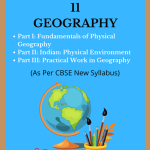NCERT Class 11 Geography Chapter 10 Atmospheric Circulation and Weather Systems Solutions to each chapter is provided in the list so that you can easily browse through different chapters NCERT Class 11 Geography Chapter 10 Atmospheric Circulation and Weather Systems and select need one. NCERT Class 11 Geography Chapter 10 Atmospheric Circulation and Weather Systems Question Answers Download PDF. NCERT Geography Class 11 Solutions.
NCERT Class 11 Geography Chapter 10 Atmospheric Circulation and Weather Systems
Also, you can read the NCERT book online in these sections Solutions by Expert Teachers as per Central Board of Secondary Education (CBSE) Book guidelines. CBSE Class 11 Geography Solutions are part of All Subject Solutions. Here we have given NCERT Class 11 Geography Part I: Fundamentals of Physical Geography, Part II: Indian: Physical Environment, Part III: Practical Work in Geography. NCERT Class 11 Geography Chapter 10 Atmospheric Circulation and Weather Systems Notes, NCERT Class 11 Geography Textbook Solutions for All Chapters, You can practice these here.
Atmospheric Circulation and Weather Systems
Chapter: 10
GEOGRAPY [ PART – I ]
TEXTUAL QUESTIONS ANSWERS
OBJECTIVE TYPE QUESTIONS
I. Fill in the blanks:
(i) ____________ winds are known as tropical easterlies.
Ans. Trade winds.
(ii) Westerlies blow in ____________ latitudes.
Ans. Middle.
(iii) Westerlies are called ____________ between 40° and 65°S latitudes.
Ans. Roaring forties.
(iv) Hot winds which blows in U.S.A. and Canada are called ____________.
Ans. Chinook.
(v) The local conventional winds are called ____________.
Ans. Tertiary.
II. Multiple Choice Questions:
1. The winds are known as tropical easterlies:
(a) Trade wind.
(b) Cyclone.
(c) Anticyclone.
(d) None.
Ans. (a) Trade wind.
2. The desert lying near the Tropic of cancer belt in India is:
(a) Sind.
(b) Thar.
(c) Sahara.
(d) None of them.
Ans. (b) Thar.
3. The velocity range of the westerlies is:
(a) 75 km/hr.
(b) 40 km/hr.
(c) 100 km/hr.
(d) 10 km/hr.
Ans. (c) 100 km/hr.
4. Monsoonal country is:
(a) India.
(b) Turkey.
(c) Brazil.
(d) Canada.
Ans. (a) India.
5. The wind which blow from high mountain to Mediterranean coast in France:
(a) Mistral.
(b) Loo.
(c) Chinook.
(d) Foehn.
Ans. (a) Mistral.
6. If the surface air pressure is 1,000 mb, the air pressure at 1 km above the surface will be:
(a) 700 mb.
(b) 1,100 mb.
(c) 900 mb.
(d) 1,300 mb.
Ans. (c) 900 mb.
7. The Inter Tropical Convergence Zone normally occurs:
(a) near the Equator.
(b) near the Tropic of Cancer.
(c) near the Tropic of Capricorn.
(d) near the Arctic Circle.
Ans. (a) near the Equator.
8. The direction of wind around a low pressure in Northern Hemisphere is:
(a) clockwise.
(b) perpendicular to isobars.
(c) anti-clock wise.
(d) parallel to isobars.
Ans. (c) anti-clock wise.
9. Which one of the following is the source region for the formation of air masses?
(a) the Equatorial forest.
(b) the Himalayas.
(c) the Siberian Plain.
(d) the Deccan Plateau.
Ans. (c) the Siberian Plain.
10. If the surface air pressure is 1,000 mb, the air pressure at 1 km above the surface will be:
(a) 700 mb.
(b) 1,100 mb.
(c) 900 mb.
(d) 1,300 mb.
Ans. (c) 900 mb.
11. The Inter Tropical Convergence Zone normally occurs:
(a) near the Equator.
(b) near the Tropic of Cancer.
(c) near the Tropic of Capricorn.
(d) near the Arctic Circle.
Ans. (a) near the Equator.
12. The direction of wind around a low pressure in northern hemisphere is:
(a) clockwise.
(b) perpendicular to isobars.
(c) anti-clockwise.
(d) parallel to isobars.
Ans. (c) anti-clockwise.
13. Which one of the following is the source region for the formation of air masses?
(a) the Equatorial forest.
(b) the Himalayas.
(c) the Siberian Plain.
(d) the Deccan Plate.
Ans. (c) the Siberian Plain.
14. What does a cell in tropics called?
(a) Polar cell.
(b) Hadley cell.
(c) Descending winds.
(d) Frost cell.
Ans. (b) Hadley cell.
15. What is tropical cyclone in Australia called?
(a) Hurricanes.
(b) Typhoons.
(c) Tornado.
(d) Willy-willies.
Ans. (d) Willy-willies.
16. What is tropical cyclone in China and Japan called?
(a) Hurricanes.
(b) Typhoons.
(c) Tornado.
(d) Willy-willies.
Ans. (b) Typhoons.
17. Circular flow of air in low pressure area is called:
(a) Cyclonic circulation.
(b) Pascal.
(c) Geomorphic winds.
(d) Western storm.
Ans. (a) Cyclonic circulation.
18. The cool air, of the high plateaus and ice fields draining into the valley is called:
(a) Mountain wind.
(b) Valley breeze.
(c) Katabatic wind.
(d) Cold front.
Ans. (c) Katabatic wind.
19. When front becomes constant, it is called:
(a) Cold front.
(b) Warm front.
(c) Stationary front.
(d) Occluded.
Ans. (c) Stationary front.
20. From severe thunderstorms sometimes spiralling wind descends like a trunk of an elephant with great force, with very low pressure at the centre, causing massive destruction on its way. Such a phenomenon is called:
(a) Hurricanes.
(b) Typhoons.
(c) Tornado.
(d) Willy-willies.
Ans. (c) Tornado.

Hi! my Name is Parimal Roy. I have completed my Bachelor’s degree in Philosophy (B.A.) from Silapathar General College. Currently, I am working as an HR Manager at Dev Library. It is a website that provides study materials for students from Class 3 to 12, including SCERT and NCERT notes. It also offers resources for BA, B.Com, B.Sc, and Computer Science, along with postgraduate notes. Besides study materials, the website has novels, eBooks, health and finance articles, biographies, quotes, and more.




